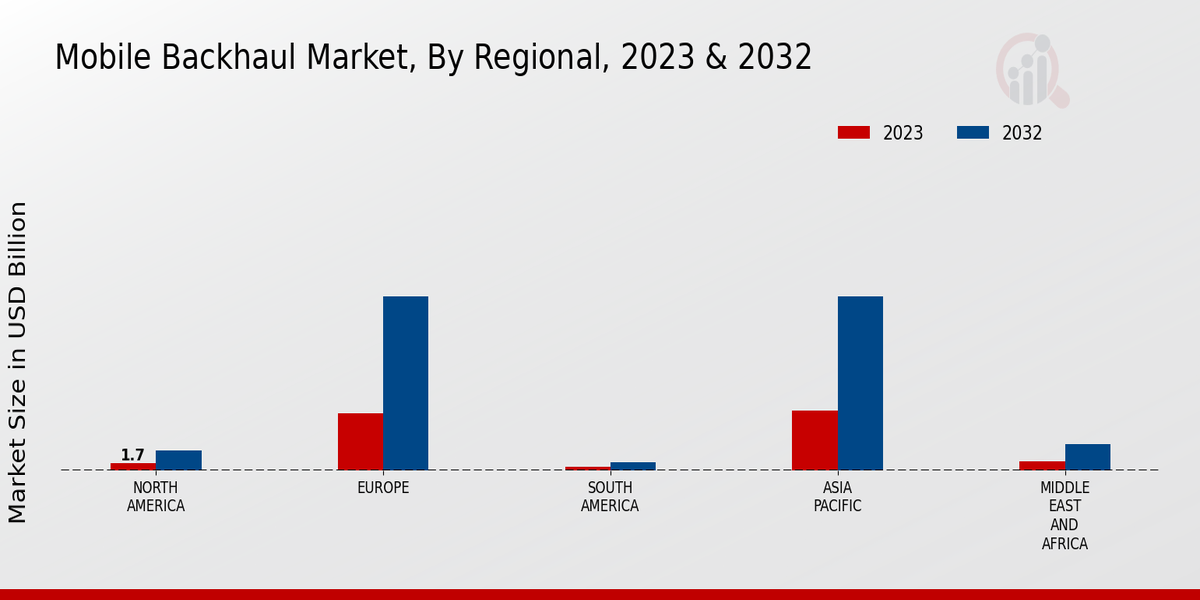Expansion of 5G Networks
The ongoing expansion of 5G networks significantly influences the Global Mobile Backhaul Market Industry. With the rollout of 5G, mobile operators require advanced backhaul solutions to support the increased data traffic and lower latency demands associated with this technology. The transition to 5G is expected to drive substantial investments in mobile backhaul infrastructure, as operators seek to ensure seamless connectivity. This shift is anticipated to contribute to the market's growth, with projections indicating a market size of 160.8 USD Billion by 2035. Consequently, the integration of innovative backhaul technologies becomes paramount to leverage the full potential of 5G.
Market Growth Projections
The Global Mobile Backhaul Market Industry is poised for substantial growth, with projections indicating a market value of 42.7 USD Billion in 2024 and an anticipated increase to 160.8 USD Billion by 2035. This growth trajectory suggests a robust demand for mobile backhaul solutions driven by various factors, including the expansion of 5G networks, the proliferation of IoT devices, and the continuous rise in mobile data traffic. The compound annual growth rate (CAGR) of 12.82% from 2025 to 2035 further emphasizes the potential for market expansion, as operators invest in advanced technologies to enhance their backhaul capabilities.
Increased Mobile Data Traffic
The Global Mobile Backhaul Market Industry is significantly impacted by the continuous increase in mobile data traffic. As users consume more data through applications such as video conferencing, social media, and cloud services, mobile operators face the challenge of upgrading their backhaul networks to handle this surge. The exponential growth in data consumption necessitates the implementation of high-capacity backhaul solutions, which are essential for maintaining service quality and customer satisfaction. This trend is expected to drive substantial investments in backhaul technologies, further propelling the market's growth as operators strive to keep pace with evolving consumer demands.
Government Initiatives and Investments
Government initiatives and investments play a crucial role in shaping the Global Mobile Backhaul Market Industry. Many governments worldwide are recognizing the importance of robust telecommunications infrastructure for economic growth and digital inclusion. As a result, they are implementing policies and funding programs aimed at enhancing mobile backhaul capabilities. These initiatives often focus on expanding coverage in underserved areas and promoting the adoption of advanced technologies. Such government support is likely to stimulate market growth, as it encourages private sector investments in mobile backhaul infrastructure, ultimately leading to improved connectivity and service quality.
Internet of Things (IoT) Proliferation
The proliferation of the Internet of Things (IoT) is a pivotal driver for the Global Mobile Backhaul Market Industry. As IoT devices become increasingly ubiquitous across various sectors, the demand for reliable mobile backhaul solutions intensifies. These devices generate vast amounts of data that require efficient transmission to centralized systems for processing and analysis. Consequently, mobile operators must enhance their backhaul capabilities to accommodate this influx of data. The anticipated compound annual growth rate (CAGR) of 12.82% from 2025 to 2035 underscores the potential for growth in this sector, as operators invest in scalable and robust backhaul infrastructures.
Rising Demand for High-Speed Connectivity
The Global Mobile Backhaul Market Industry experiences a surge in demand for high-speed connectivity, driven by the proliferation of mobile devices and data-intensive applications. As consumers increasingly rely on mobile broadband for activities such as streaming and online gaming, mobile operators are compelled to enhance their backhaul infrastructure. This trend is reflected in the projected market value of 42.7 USD Billion in 2024, indicating a robust growth trajectory. The need for faster and more reliable connections necessitates investments in advanced backhaul technologies, which are essential for meeting the escalating expectations of users worldwide.























